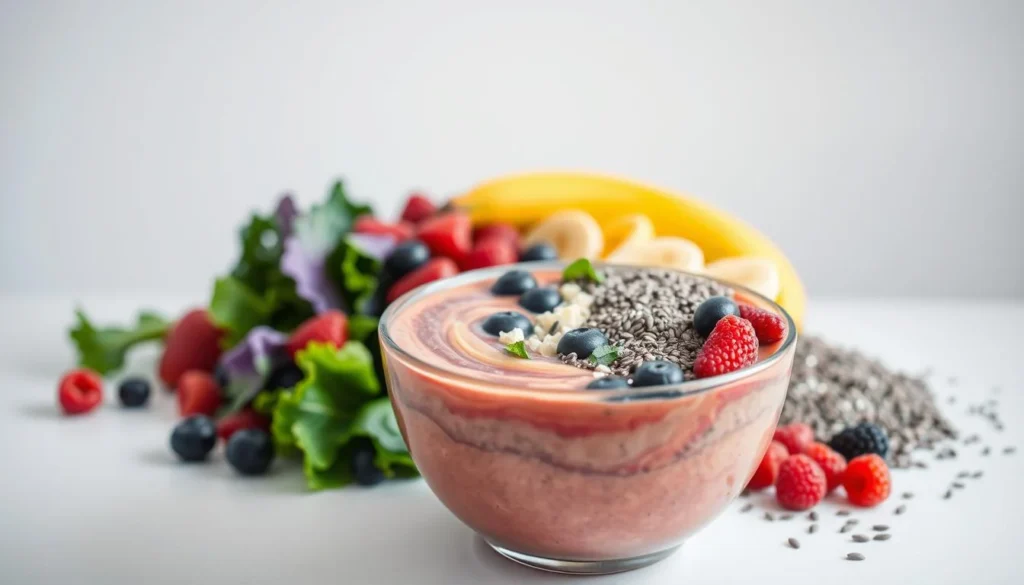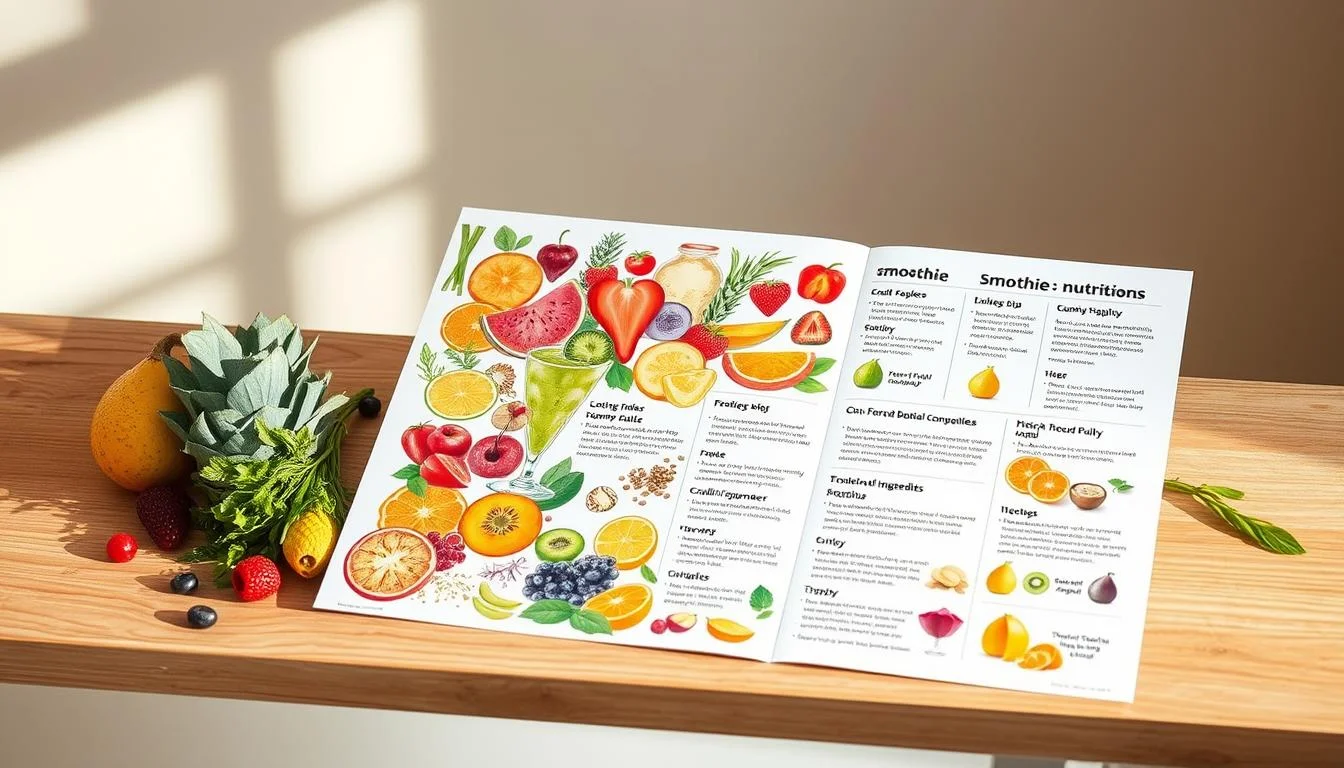Are Smoothies Healthy? The Surprising Truth
Table of Contents
Ever wondered if those vibrant, Instagram-worthy smoothies are truly as healthy as they seem? You’re not alone. With only 1 in 10 Americans eating enough fruits and vegetables, smoothies have become a quick fix. But are smoothies healthy? The answer might surprise you.
Smoothie nutrition is more complex than most people think. These blended drinks promise quick nutrition but can hide unexpected challenges. Some smoothies have as many calories as a cheeseburger and more sugar than soft drinks. This turns a seemingly healthy drink into a potential dietary pitfall.
As we explore the world of smoothies, you’ll discover the truth behind these trendy drinks. We’ll show you how to make smarter choices and avoid hidden nutritional traps. You’ll learn how to turn your smoothie game from potentially harmful to genuinely nutritious.
Get ready to learn everything you need to know about smoothie nutrition. We’ll guide you on how to create drinks that truly support your health goals. Your journey to smarter, healthier smoothies starts now.
Understanding What Makes a Smoothie
Smoothies are a great way to get lots of nutrients in one drink. They mix fruits, veggies, and protein into a tasty drink. Knowing what goes into a smoothie is important for making a good one.
Choosing the right ingredients is the first step to a great smoothie. The USDA says adults should eat two and a half cups of veggies and two cups of fruits a day. Smoothies can make it easy to meet these goals.
Basic Components of a Smoothie
A smoothie has a few main parts:
- Liquid base (water, milk, plant-based milk)
- Fresh or frozen fruits
- Vegetables
- Protein sources
- Optional add-ins like nuts, seeds, or sweeteners
Different Types of Smoothies
There are many types of smoothies for different needs:
| Smoothie Type | Key Characteristics | Primary Ingredients |
|---|---|---|
| Fruit Smoothies | Sweet and refreshing | Berries, bananas, tropical fruits |
| Vegetable Smoothies | Nutrient-dense and green | Spinach, kale, cucumber, lettuce |
| Protein Smoothies | Muscle recovery and satiety | Protein powder, Greek yogurt, nuts |
Common Ingredients Used
Here are some popular smoothie ingredients:
- Leafy greens for nutrient boost
- Fresh and frozen fruits for natural sweetness
- Protein sources like yogurt or protein powder
- Healthy fats from nuts and seeds
Most adults in the U.S. don’t eat enough fruits and veggies. Smoothies are a good way to get more of these important foods.
The History and Evolution of Smoothies
Smoothies have a rich history that started in Brazil. There, batidas introduced the idea of blended fruit drinks. In the 1960s, Americans began looking for new ways to eat fruits and veggies.
Big changes came with the invention of powerful blenders. Smoothie King, started by Steve Kuhnau, made smoothies popular in the U.S. By the mid-1980s, “smoothie” was a common term in recipes and trademarks.
- 1960s: Health food movement sparks interest in blended drinks
- Mid-1980s: “Smoothie” becomes a recognized culinary term
- 2000s: Home smoothie preparation becomes mainstream
Are smoothies healthy? Yes, they’ve become a key part of a healthy diet. Today, smoothies are more than just fruit. They’re packed with nutrients and can be a quick, healthy meal.
| Decade | Smoothie Characteristics |
|---|---|
| 1960s | Basic fruit blends |
| 1980s | Commercial smoothie businesses emerge |
| 2000s | Nutritional diversity and home preparation |
The trend of smoothies keeps growing. People are trying new ingredients to make their smoothies healthier and tastier.
Are Smoothies Healthy: Benefits and Risks
Smoothies can be a mixed bag when it comes to health. They might be a quick way to get more nutrients, but knowing their real effects is key. This helps you make better food choices.

A fresh, vibrant smoothie bowl with an array of colorful fruits, vegetables, and superfoods. In the foreground, a thick, creamy smoothie with swirls of different hues. In the middle ground, an assortment of chopped ingredients – kale, spinach, berries, bananas, and chia seeds – arranged artfully around the bowl. The background is a clean, minimalist backdrop, highlighting the natural goodness of the ingredients. Soft, diffused lighting casts a warm, natural glow, emphasizing the nutrient-dense textures and vibrant colors. The overall composition conveys the health benefits and nutritional value of a well-crafted smoothie.
Looking at smoothies, it’s important to see beyond their good looks. Experts say a few things about smoothies:
- Adults need 1.5 to 3.5 cups of fruits and vegetables daily for optimal health
- Only 1 in 10 adults get enough fruits and vegetables
- Smoothies can provide concentrated nutrient sources
Nutritional Value
Smoothies pack a lot of vitamins and minerals. They can turn several servings of fruits and veggies into one drink. But, the good stuff depends on what you put in it.
Potential Health Concerns
Not every smoothie is good for you. There are some risks:
- Excessive calorie consumption
- High sugar content
- Potential nutrient imbalances
Impact on Blood Sugar Levels
Smoothies can affect blood sugar levels. Their high sugar content can lead to quick spikes in blood sugar. This is especially true for those with diabetes or trying to lose weight.
Moderation and ingredient selection are key to creating a healthy smoothie.
Smoothies can be good or bad for your health. By knowing what’s in them and choosing wisely, you can make them a healthy part of your diet.
Hidden Calories in Commercial Smoothies
Exploring smoothie nutrition can reveal surprising facts. Many commercial smoothies are calorie bombs. They are marketed as healthy but can actually hinder your diet goals.
Here are some shocking stats on popular smoothies:
- Naked Strawberry Banana Smoothie contains 52 grams of carbohydrates per serving
- This is as much as 5 pieces of bread
- Bolthouse Farms Green Goodness smoothie has 56 grams of carbohydrates per serving
These smoothies can cause big blood sugar spikes. This leads to energy crashes and more hunger. It might even cause weight gain, despite being seen as healthy.
When picking smoothies for diet plans, check the labels carefully. Commercial smoothies often have:
- Sweetened fruit juices
- Processed yogurts
- Hidden sugar sources
- Unnecessary calories
For better choices, look at smoothies with less carbs. Noka Superfood Smoothies have more fiber and protein. They also have fewer sugar risks.
The Truth About Sugar Content in Smoothies
Smoothies can be tricky when it comes to sugar. They are often seen as healthy, but they can have a lot of sugar. Knowing about sugar in smoothies is key to seeing if they fit into a healthy diet.
When looking into if smoothies are healthy, sugar is very important. The natural sugars from fruits can raise your blood sugar quickly. This is especially true when you blend fruits into a liquid.
Natural vs. Added Sugars
Not all sugars are the same. Here’s a look at the sugars in smoothies:
- Natural Sugars: Straight from whole fruits
- Added Sugars: Made from artificial sweeteners or processed sugar
Understanding Fructose Impact
Fructose, the main sugar in fruits, can quickly raise blood sugar. Blending fruits means you get more sugar than eating them whole.
| Smoothie Size | Sugar Content | Recommended Limit |
|---|---|---|
| 250ml | 25g | 30g daily |
| 300ml | 33g | 25g for women |
| 400ml | 14g | 37.5g for men |
How to Reduce Sugar in Smoothies
To keep smoothies healthy, try these tips:
- Use more veggies than fruits
- Add protein like Greek yogurt
- Include healthy fats from avocado or nuts
- Stay away from extra sweeteners
“Smoothies can be nutritious when prepared thoughtfully and consumed in moderation.”
Making Healthier Smoothie Choices
Making smoothies at home lets you control what goes into them. Green smoothies are great for getting more vitamins and minerals. They also help keep calories low.
Choosing the right ingredients is key to making healthy smoothies. Aim for a mix that’s full of nutrients but low in sugar.
- Choose protein-rich bases like plain yogurt or unsweetened almond milk
- Include fiber-packed vegetables such as spinach, kale, and cucumber
- Add healthy fats from ingredients like avocado or chia seeds
- Use whole fruits instead of fruit juices to minimize sugar content
Start with mild-tasting veggies like spinach when making green smoothies. A mix of cucumber, pineapple, and spinach makes a tasty, healthy drink. It helps keep blood sugar stable.
| Ingredient Category | Recommended Options | Nutritional Benefits |
|---|---|---|
| Proteins | Plain yogurt, tofu, nut butters | Muscle support, satiety |
| Vegetables | Spinach, kale, carrot | Vitamins, minerals, fiber |
| Fruits | Berries, mango, banana | Antioxidants, natural sweetness |
Remember, portion control is important. A good smoothie can be a balanced meal or snack. It gives you energy without causing blood sugar spikes. By making smart choices, you can turn your smoothies into powerful health boosters.
Protein and Fiber: Essential Smoothie Components
Making nutritious protein smoothies means knowing the key parts that make a drink a meal. It’s not just about blending ingredients. It’s about making a drink that’s good for your body.
When making protein smoothies, pick ingredients that are both nutritious and tasty. You want a drink that keeps you full and gives you energy.
Best Protein Sources for Smoothies
Choose protein sources that fit your diet and taste. Here are some top picks:
- Greek yogurt (15-20 grams of protein per serving)
- Protein powder (plant-based or whey)
- Nut butters
- Silken tofu
- Chia seeds
Fiber-Rich Ingredients
Fiber is key in smoothie nutrition. It helps keep blood sugar stable and aids digestion. Good fiber sources include:
- Oats
- Spinach
- Berries
- Chia seeds
- Flaxseed
By picking the right protein and fiber, you can make your smoothie a nutritional powerhouse. It will help you reach your health and wellness goals.
Green Smoothies and Their Benefits
Green smoothies have changed the way we eat, making it fun to get more nutrients. They mix leafy greens with fruits to make drinks full of good stuff. These drinks can really change your diet for the better.
Green smoothies are full of important nutrients. They help you eat more veggies, which is good for you. The goal is to eat 2.5 cups of fruits and veggies a day. These smoothies make it easy and tasty to reach that goal.
- Rich in antioxidants from leafy greens like kale and spinach
- Supports digestive health through high fiber content
- Boosts energy without sugar crashes
- Enhances nutrient absorption through blending
Green smoothies are great for your health. They help fight off bad stuff in your body, keep your immune system strong, and make you feel better overall. Greens like spinach, kale, and Swiss chard add special nutrients that help your body work its best.
| Green Smoothie Type | Key Nutrients | Health Benefits |
|---|---|---|
| Kale-Based Smoothie | Vitamin K, Vitamin C | Bone health, immune support |
| Spinach Smoothie | Iron, Magnesium | Energy production, muscle function |
| Collard Green Smoothie | Calcium, Fiber | Digestive health, bone strength |
When making your green smoothies, aim for a mix of greens and fruits. Add some protein like chia seeds or plant-based powders for extra nutrition. This way, you get a drink that’s full of good stuff for your body.
Smoothies for Weight Management
Diet smoothies can be a great tool for managing your weight. They help control portions and increase nutritional intake. This supports your fitness goals.

A sun-drenched kitchen counter, bursting with a vibrant assortment of fresh fruits and vegetables. In the foreground, a high-powered blender whirs to life, capturing the essence of a weight-loss smoothie in the making. Ripe bananas, crisp leafy greens, and juicy berries swirl together, their colors blending into a creamy, nutrient-dense elixir. Surrounding the blender, a collection of sleek glass jars filled with various superfoods – chia seeds, flaxseeds, and protein powder – ready to be added for a customized nutritional boost. The scene is bathed in warm, natural light, conveying a sense of health, vitality, and the simple pleasure of crafting a guilt-free indulgence for weight management.
To make effective diet smoothies, you need to know about portion control and timing. Not all smoothies are good for losing weight.
Portion Control Guidelines
It’s important to manage smoothie portions for weight management. Here are some tips:
- Limit smoothie size to 12-16 ounces
- Use measuring cups for consistent portions
- Choose low-calorie, high-nutrient ingredients
- Aim for 300-350 calories per smoothie
Optimal Smoothie Timing
Timing your weight loss smoothies can make them more effective:
- Morning: Replace breakfast for controlled calorie intake
- Pre-workout: Provide energy without heavy digestion
- Post-workout: Support muscle recovery and satiety
- Afternoon snack: Curb hunger between meals
Choose smoothies with balanced nutrition. Try the 5-Ingredient Go-To Green Smoothie (215 calories, 13g protein) or the Strawberry Protein Shake. They help manage cravings and keep your energy up.
Smart Tips for Smoothie Preparation
Making tasty and healthy smoothies needs some special tips. With a few smart moves, you can turn a simple drink into a nutritional powerhouse.
- Use frozen fruits to create a thick, creamy texture without extra calories
- Add ice cubes for additional consistency and frostiness
- Experiment with unique ingredients like avocado for creaminess
- Incorporate chia seeds to boost nutrition and texture
When making smoothies, think about these nutritional boosters:
- Blend leafy greens for added vitamins
- Include healthy fats like nut butters
- Use natural sweeteners sparingly
- Consider protein powder for extra nutrition
“The secret to a perfect smoothie is balancing flavors and nutrients.” – Nutrition Expert
Pro tip: Prep your ingredients in advance by portioning fruits and vegetables into freezer bags. This makes morning smoothie preparation a breeze! Smart preparation can turn your smoothie into a nutritional powerhouse.
Your blender is crucial for smoothie success. Get a high-quality blender that mixes ingredients well. This ensures your smoothies are smooth and consistent.
Reach more healthy smoothies ideas by visiting the following:
- Benefits of Drinking Green Juice
- Discover Amazing Kale in Smoothies Benefits Today
- Health Benefits of Smoothies: Your Guide to Wellness
- Is Smoothie Healthy: Benefits of Blended Drinks
Conclusion
Smoothies can be great for your health if you make them right. They are especially good for people who are active. They give you important nutrients and help your muscles recover.
What you put in your smoothie matters a lot. Adding spinach, berries, and lean proteins makes them very nutritious. So, are smoothies healthy? It really depends on what you choose to add.
It’s important to balance your smoothie ingredients. Use top-quality proteins and add different fruits and veggies. Try to avoid too much sugar. Seen as a way to boost your diet, smoothies can help with fitness, digestion, and overall health.
Knowing about smoothie nutrition helps you make better food choices. Whether you’re an athlete or just want to eat better, smoothies can be a tasty part of a healthy diet.
FAQ
Are smoothies actually healthy?
Smoothies can be good for you, but it depends on what’s in them. They can have vitamins and minerals. But, some smoothies have a lot of sugar and calories. To make a healthy smoothie, mix fruits, veggies, protein, and healthy fats.
How much sugar is in a typical smoothie?
Sugar in smoothies varies a lot. Commercial ones can have 30-50 grams of sugar, like 7-12 teaspoons. Making your own smoothies lets you use less sugar by adding more veggies.
Can smoothies help with weight loss?
Yes, they can help with weight loss if made right. Choose low-sugar, high-protein smoothies with lots of fiber. Add leafy greens, protein powder, and healthy fats for a filling drink.
What are the best ingredients for a healthy smoothie?
Good smoothie ingredients are leafy greens, low-sugar fruits, protein sources, and healthy fats. Use unsweetened almond milk or water as your liquid base.
Are green smoothies really better?
Green smoothies are packed with nutrients and less sugar than fruit-based ones. They’re full of vitamins, minerals, and antioxidants. Just make sure they taste good while being healthy.
How often should I drink smoothies?
Drink smoothies in moderation. They should be a supplement, not a whole meal. 1-2 smoothies a week can be healthy, especially if they’re not too sweet.
What’s the difference between homemade and store-bought smoothies?
Homemade smoothies let you control the ingredients, keeping sugar and calories low. Store-bought ones often have added sugars and extra calories that can harm health.
Can smoothies replace a meal?
Some smoothies can replace a meal if they have the right mix of nutrients. Look for ones with 300-400 calories, protein, veggies, and a bit of fruit.
Are protein smoothies good for you?
Protein smoothies are great for muscle recovery and keeping you full. Use high-quality proteins like whey or Greek yogurt. Just watch the sugar and calorie count.
How can I make my smoothies healthier?
For healthier smoothies, use unsweetened bases and add more veggies than fruits. Include protein, healthy fats, and avoid added sugars. Try cinnamon for natural sweetness and extra health perks.
How did you find our Post?
There are no reviews yet. Be the first one to write one.

